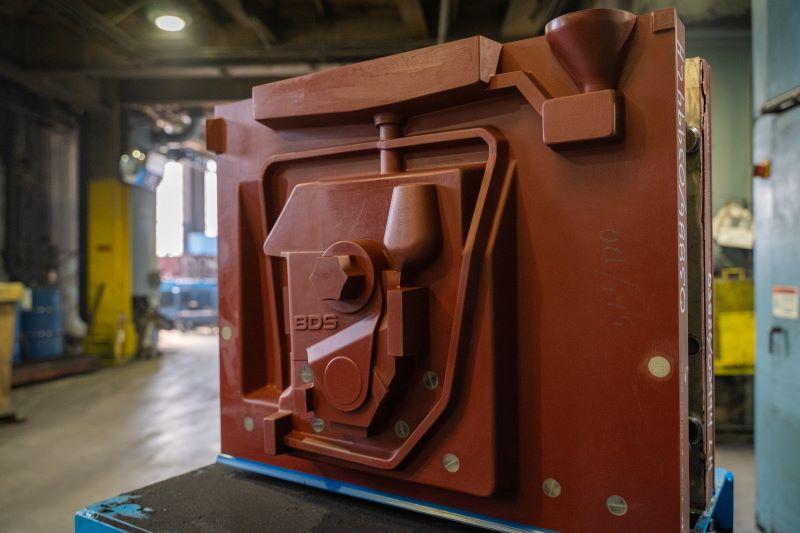In our business, we talk a lot about ductile iron nodularity, which is a prime indicator of quality in ductile castings.
Both ductile iron and cast iron contain graphite, but the shape of the graphite differs significantly, affecting the material properties. This distinct structure makes ductile iron more suitable for specific applications due to its enhanced malleability and durability. But what is ductile iron nodularity, why is it beneficial, and how do we optimize our casting process to achieve it?
What is ductile iron nodularity?
In short, ductile iron nodularity refers to the prevalence of spheroidal graphite nodules within a ductile iron casting's microstructure. We can measure that by how round the nodules are (graphite nodularity percentage) and how much of a casting's surface area they occupy (graphite area percentage).
Nodularity is more than desirable — it's why ductile iron is ductile (able to stretch and bend without breaking)! Because of its paramount importance, ductile iron is often referred to as nodular or spheroidal graphite (SG) iron. In this unique microstructure, the graphite forms into spherical shapes rather than flakes, enhancing the pliability and stress resistance of ductile iron compared to regular cast iron.
Achieving more nodular iron
To achieve superior ductile iron nodularity in our ductile iron production process, there are a few things we must pay attention to. This includes a deeper understanding of the properties of ductile iron materials.Here are several factors that contribute significantly to the structural integrity and performance of ductile iron:
- What we start with — the base iron and accompanying metals a melting furnace is "charged" with
- What we put in — the makeup of the magnesium treatment that encourages nodulization
- How we put it in — i.e. inoculation method
- Temperature phasing of the casting as it cools
Let's discuss these considerations one by one.
Starting strong with purer pig iron
Pig iron (aka crude iron) forms the foundation of the ductile iron production process and the overwhelming percentage of its composition, so we must start right. While ductile iron can be created using steel scrap, the primary feedstock for most foundries is pig iron, which offers superior properties. Pig iron has low residual elements and consistent chemistry, contributing to better casting and manufacturing processes.
We do not want to spend a lot of time and energy "rolling around in the mud" with our pig iron — filtering out residual elements that will interfere with nodule formation ( e.g. titanium, arsenic, lead, tin, antimony, bismuth, and especially sulfur) and/or dirty our metal matrix structure with carbides (chromium, molybdenum, vanadium, manganese).
Beginning with a cleaner canvas provides a clearer path to casting with desirable mechanical properties, without incurring high costs due to inefficiency and processing defects.
The magic of magnesium
You may have heard of "influencers" in social media — well, in a ductile iron foundry, magnesium typically plays that role. In nature, it's always affiliated with other elements, and it enjoys causing reactions. When carefully incorporated into our molten iron, it promotes a phenomenon known as diffusion, pulling carbon and nitrogen ions away from the carbon that is needed to form our spheroidal graphite nodules; this frees it up for other engagements.
As we just mentioned, introducing elemental magnesium to the melt is not all that practical — given its proclivity to form compounds, it's difficult to isolate. Furthermore, its low density and boiling point would pose a significant safety risk (vapor pressure buildup = exploding gas bubbles), since they are so out of equilibrium with those of iron.
To circumvent this, we introduce a small amount of magnesium to the melt through a master alloy (magnesium plus another metal such as nickel, silicon, or copper) with thermodynamic properties more consistent with iron.
The intricacies of inoculation
As molten iron is poured over the master alloy, fine magnesium particles are infused into the melt, a process known as inoculation. There are multiple ways to do this, but at Urick, we favor the vertical in-mold method, in which the magnesium-containing alloy is positioned in a reaction chamber built into the inlet of the casting mold. This encourages an even distribution of inoculants throughout the casting, and in turn, eutectic solidification as the part cools — meaning the graphite and iron firm up at the same rate (and conversely would melt again at a single temperature lower than the constituent parts — eutectic is Greek for "well-melting").
The size of the inoculation chamber, the rate at which we pour the molten iron, and the dissolution properties of the magnesium alloy can be adjusted depending on the properties we want in the finished casting.
Temperature phasing
If getting the graphite molecules together is step one to achieving ductile iron nodularity, step two is getting strong networks (crystalline matrices of iron) to form around them. We can manipulate which microstructures form by phasing the casting through various temperature ranges as the part cools. We also might apply any of the heat treatments of ductile iron, such as austempering, after production.
ductile iron Nodularity standards
The ultimate objective of the ductile iron production process is to achieve a 100% ductile iron nodularity rating — meaning the graphite nodules are perfectly spheroidal. When a graphite particle's length is more than twice its diameter, it is classified as a floccule and disqualified from the nodule count. Urick is proud to produce castings that regularly exceed the ASTM A536 standard of 80% nodularity, achieving 90% nodularity or higher.
Urick does ductile differently
Nodular iron requires nodules, and our proprietary ductile iron production process gets higher nodule counts and nodularity than the competition. For consistency and capability, look no further than Urick.



